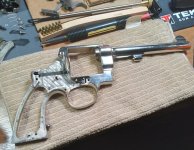Very interesting and educational thread, to be sure. Now, for a question or two of my own:
I have a TL with what appear to be British or Canadian proof marks all over it (crossed flags; what appear to be three crossed arrows in several locations on the frame; usual 2-line S & W manufacturer/patent stamping on top of barrel and grips pencil-numbered to the gun). Gun appears to have been fired very little. Blue finish is worn (speckled), but original. Grips & gold medallions in excellent condition. No rust or pitting anywhere. Lock-up and timing are perfect. Bore is near perfect. Case hardening of hammer and trigger are near perfect. No cylinder end shake. Intact lanyard swivel on bottom of grip frame, not covering s/n which is 43XX and that is stamped in the usual places. However, there are no caliber stampings anywhere on the piece. Without slugging the chambers and bore to be sure, it appears to be a .45 caliber gun judging visually by the bore and chamber diameters.
Could this be a caliber .455 Webley or .455 Eley? The chambers are ever so slightly recessed (less than 1/64th inch) and, since the serial number is intact on the rear face of the cylinder, I doubt it has been milled to accommodate .45 Colt, 45 ACP or the like. I doubt it's a .44 caliber anything, either.
Without anyone seeing it, would anybody hazard a guess as to what caliber this might be and why would S & W have omitted the caliber stamp on the gun? I don't want to fire it since its so old but I am curious.
Thanks in advance for any help in determining its caliber. If pictures are necessary, I can post them. If no help here, I will letter it.











